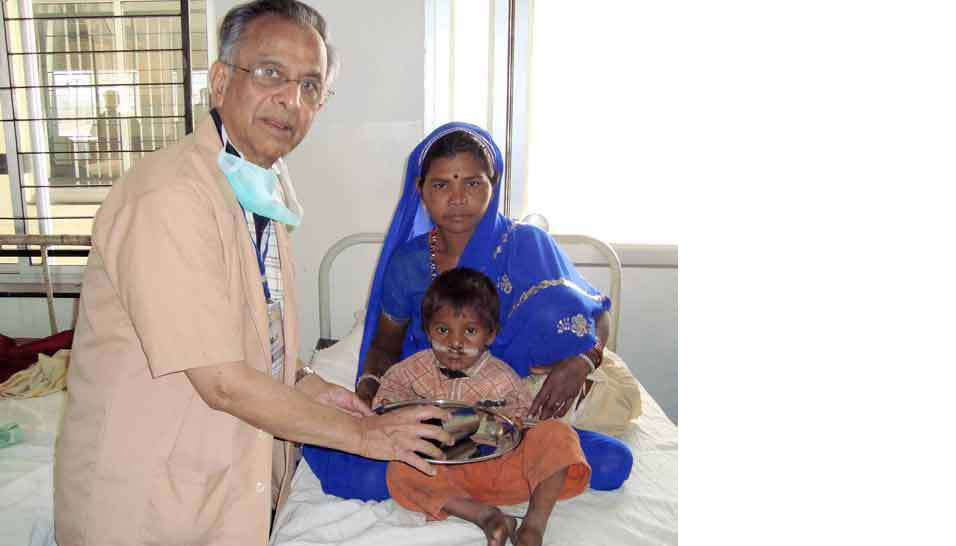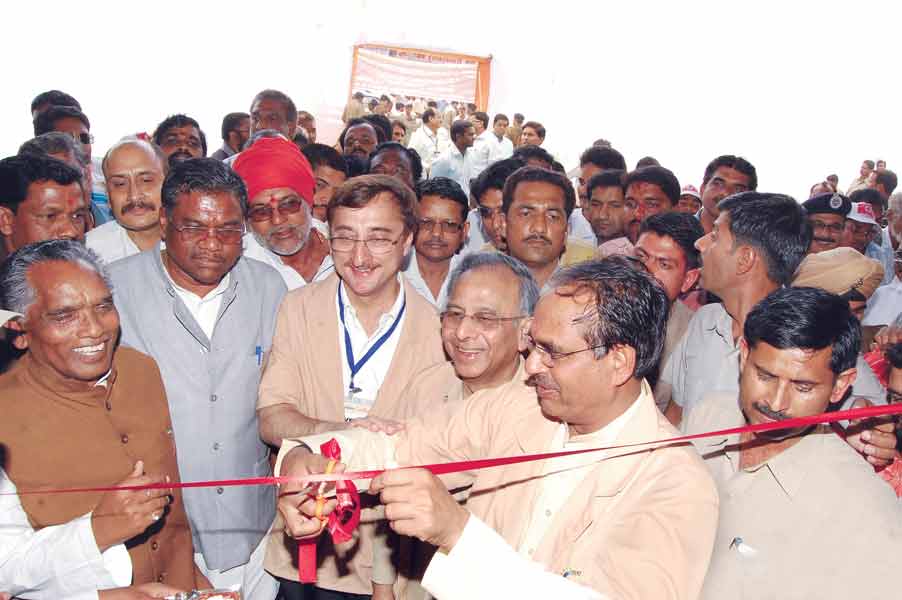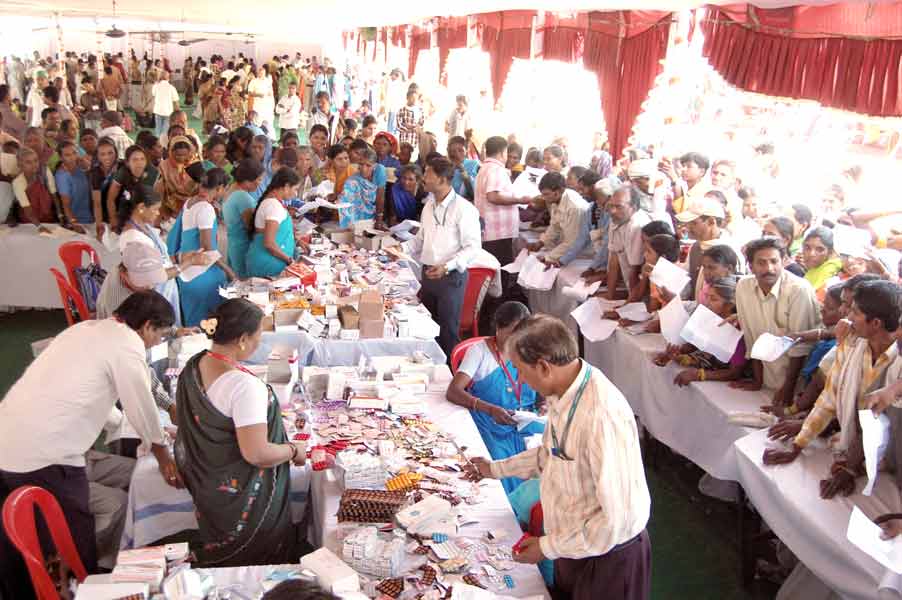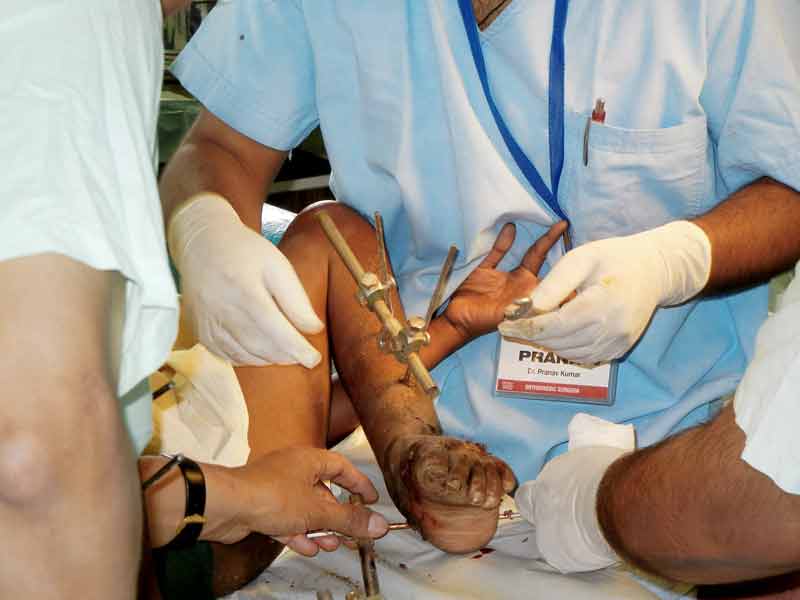

Once the African medical missions (MM) were on track, “I thought we are touching the needy people there, but there is great need for medical services in India too,” says PRIP Rajendra K Saboo. What better place for the first Indian mission than Kalahandi in Orissa, which was making headlines for starvation deaths? “So I talked to DG (3260) Subhash Sahu, and he jumped at the idea. With the four specialties of eye, orthopaedics, dental and plastic surgery, we went there immediately after Republic Day in 2006.”
Challenging beginning
But it wasn’t a smooth beginning. Eminent Plastic Surgeon Dr Chari, then HOD at the PG Institute of Medical Education and Research, Chandigarh, did a simple cleft lip surgery on a four-year-old girl. Unfortunately, the mother didn’t tell the doctors the child had taken milk. Administration of general anaesthesia caused complications and the child was “so critical that Mrs Chari, HOD, Anaesthesiology, PGI, Chandigarh, sat with the child the whole night,” recalls Saboo. All social engagements were cancelled and “we headed to a temple to pray for the child. Around 4 am, she called and confirmed that the child was now out of danger. We were relieved and took that as divine blessings for moving forward with the medical missions in India!”
Saboo says a unique feature of the Indian medical missions, which are now 10 years old, is that in States like MP, the Government has been extremely helpful. “That, combined with the hard work of Rotarians, and the amazing medical expertise of our doctors, has contributed immensely to the success of these missions.”

For example, in 2010, PDG of D 3261 Vivek Tankha, a leading advocate and philanthropist and now a Rajya Sabha MP, “encouraged us to go to Mandla, a tribal region near Jabalpur which is a deprived area without good medical facilities. That experience gave a new dimension to our MMs, and it was here that we named our medical missions in India RAHAT (Rotary’s Active Hands Are Touching; it also means solace or relief in Hindi)”. The support they got from the administration and the government, beginning with the Chief Minister, gave “us the idea how governments could help. Vivek opened many doors for our medical missions in MP and PDG Subhash Garg took the responsibility to coordinate from D 3080. Since then, Subhash has been the sheet anchor of our district for most of the inter-district medical missions within India.”
The mission was a resounding success — the Government doctors assisted in the OP and medicines were also given — and over 49,600 outpatients were treated, and 2,200 surgeries performed.
A very challenging mission was in Jagdalpur in Chhattisgarh, which borders a Naxal area and the medical facilities there are very scanty.
“The Chief Minister spent a day with us in the hospitals. So total was the Government cooperation, that as the area has power shortage, strict instruction were given that the three MM hospitals should not experience any power breakdown during those seven days. Never before have I had a Chief Minister calling me on my cell phone to thank us for the medical mission!”
Each of the Indian MMs have been of seven days’ duration; the second one was also done in Orissa (Baripada) in March 2007. This was a tribal area, “and a few miles from the Naxal belt. In both Kalahandi and Baripada, our living conditions were very basic, which didn’t matter; after all we were there for service. We are thankful to the Rotary district there and PDG D N Padhi for their pivotal role.”
There were two more MMs in Orissa; Sambalpur, recommended by the local Rotarians, in 2009 and another small one in 2011. In 2012, they returned to MP, where the MM had got great support from the Government, led by the CM himself; this time to Chhindwara, about three hours by road from Nagpur. It saw the largest OP number at a whopping 73,864. The next camp was once again in MP and the tribal area of Jhabua.

Mission in Udhampur in 2013. PDGs Dr Rajiv Pradhan, Manpreet Singh Gandhoke and Subhash Garg are also in the picture.
Most challenging mission
In 2012, an MM was done in Sikar in Rajasthan. “Immediately after that came the most challenging of our missions in Udhampur in Jammu, an area of conflict and militancy. We got PDG Rajiv Pradhan’s help too, and many doctors from his district joined. Over 1,750 outpatients were done; they all came from the hills and faraway places. This was one of the most challenging, fulfilling and memorable MMs,” says Saboo.
Next followed, in March 2014, a mission in Neemuch in MP, where over 43,000 outpatients were attended to. “The Rotarians of D 3040 were fully involved; there was remarkable organisation and those from D 3260 helped too, as they did in all our missions in Madhya Pradesh.”
Another challenging mission was in Jagdalpur, Chhattisgarh, a 4-hour drive from Raipur. “Again, this borders a Naxal area and the medical facilities there are very scanty. They have a Christian medical hospital and government hospitals, but the latter are not fully manned; it’s a place where nobody wants to go.”
In all the medical missions, two people always made an earlier trip to study the facilities, the needs etc, and only then the mission was planned and executed. This was done in Jagdalpur too, where the District Magistrate was very positive but from the “Government side there was a cold reception, and we weren’t too sure what to do.” But Saboo knew the Chattisgarh Governor Balram Das Tandon, “who was from Amritsar. I talked to him and he said I will get all doors opened for you.”

Just two days earlier, 10 policemen were killed by the Naxals and the whole area was very tense. “It’s a very scary place but the local Rotarians and the leadership of the district were totally dedicated. The State Governor came by a helicopter, took a round of all the hospitals and met all the surgeons. And we had a very fulfilling mission.”
Restoring dignity
Saboo says every medical mission has unraveled for all the participants the human aspect, and the kind of pain and misery so many Indians live in due to lack of good medical facilities.
He narrates the story of a 10-year-old girl, who fell into an open chullah at the age of 1, and as a result of the terrible burn injuries, her leg from the knee downward got stuck to her thigh and “till the age of 10, she had been living virtually with just one leg. Dr R Bharat, now a DG of D 3250, is a plastic surgeon and veteran of many medical missions.” Assisted by other surgeons, they separated the girl’s lower leg from the thigh, made the leg straight (see picture below) and “by the time we left, she was doing very well and he said at least she will be able to walk on both her legs, requiring support of course, but she’ll be able to lead a life of dignity.”
The most demanding MM mission was done in Dimapur, Nagaland. “There too we had to work under very difficult circumstances, but the local Rotarians — Chandu Agarwal, then DG, worked very hard. We had 18,000 outpatients and did some very difficult surgeries. Unfortunately, one life was lost.”
Upcoming missions
In February, a mission is planned to Morena near Gwalior in MP again. “MP has given us outstanding recognition and support. We are happy to do at least one medical mission in India every year.
A new addition PDG Rajiv Pradhan did last year was to organise within the district some 1,000 surgeries. In our district (3080) too, PDG Arun Sharma, under the Government’s Rural Health Programme is organising some programmes from March 15–20 in Himachal Pradesh and from April 25–30 in the hills in Rohru. These are smaller medical projects and a new dimension we are adding to our medical missions.”
Saboo adds, “The credit for the missions goes to our dedicated doctors who leave their regular work and take out time; all this in the total spirit of service”.
(Read the names of all the Doctors who have participated in these medical missions on https://wordpress-132319-5230970.cloudwaysapps.com/wp-content/uploads/2017/01/MM-doctors_1.pdf)
Moments and memories
PRIP and architect of the Rotary Medical Missions, Rajendra Saboo, treasures some indelible memories from the MMs in India and Africa. He recalls how in Mandla, “where we were working in four different places, one day I decided to walk to the Civil Hospital, our biggest centre, rather than go by car. I was wearing our normal MM tee-shirt and the route was through the bazaar. Suddenly a motorcyclist stopped me and asked: Are you part of the MM? When I said yes, he offered me a ride and insisted that I accept it, as it would be a pleasure for him. That was the first time I rode the pillion of a motor bike!”
They chatted on the way, and the man said: “What you people are doing is beyond our imagination!”
He has many such happy memories. In one of the medical missions, where the MP government wholeheartedly participated, the people of the town also pitched in enthusiastically. There were some 37,000-odd outpatients and as in India every patient is invariably accompanied by at least two attendants, over 7 days about 1.5 lakh people visited the MM.
“The way the people of the town united and participated in this mission was so heartening. For example, one community said we will organise the entire water supply, some other society said on this day we’ll take care of the food for the patients, doctors and attendants. Such gestures really enthused and encouraged us,” says Saboo.





